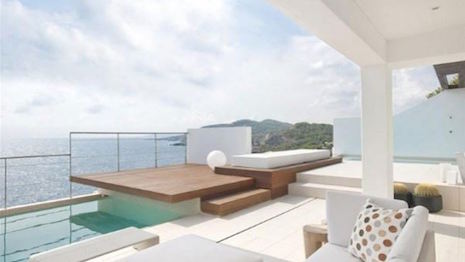By Paul Boomsma
As global wealth has continued to increase over time, so too has the demand for luxury properties.
While the affluent have always loved luxury real estate, the period between the early 1970s and now has seen a dramatic increase in the number of high-net-worth individuals with a seemingly insatiable appetite for, interest in and an overall cultural focus on real estate.
As their ability to invest in such lifestyle-forward discretionary purchases has increased, the instances of properties priced at $1 million or more has surged – unlike anything we have seen in the past.
Market talk
While the Great Recession resulted in a temporary dip in this trend in the late-2000s, consumers quickly gained confidence in the market, with investors and those with means rushing back into real estate, often leveraging their position with all-cash purchases.
Real estate developers happily met this demand by quickly returning to building, particularly in high-net-worth markets such as Hong Kong, London and New York.
As a result, the high end of the market led the recovery of real estate, with what some may say was a frenzied, overhyped return.
At the same time, we began to see the global economy have an impact on the luxury market, as global wealth became more widespread and economies such as China produced significant real estate investors.
The strength and diversification opportunities represented by the global economy have influenced the confidence levels of high-net-worth individuals.
In fact, contemporary affluent individuals have exceptional confidence, particularly about their own personal wealth and their ability to maintain it.
This confidence is something we did not see just a few years ago and is very good for the real estate market, in general.
Unique moment in time
Strong, confident and savvy world travelers are also very educated on the ways of the world and extremely sensitive to the impact of global events.
For example, they understand innately that economic change such as Brexit, unrest such as the refugee crisis and uncertainty such as the United States presidential election affect the global economy. They keep their fingers on the pulse and are ready to turn on a dime if needed.
 Paul Boomsma is president of Luxury Portfolio International and chief operating officer of The Leading Real Estate Companies of the World
Paul Boomsma is president of Luxury Portfolio International and chief operating officer of The Leading Real Estate Companies of the World
It is in this landscape that the global luxury real estate market faces a unique moment in time, as the post-recession frenzy has begun to settle or correct.
In fact, in most global real estate markets today, we see a very healthy environment, with solid levels of inventory and a return to realistic absorption rates – or the amount of time it should take to sell a property based on the price and the amount of inventory in that market.
Honest conversation is critical
Top luxury real estate agents understand the more measured pace of a healthy market, and the best ones will ensure that their clients get it, too.
For home owners wondering why their home is not home selling, it is critical to have an in-depth conversation with the agent about what the likely market for the property may be.
The best agents consider many factors when creating a customized marketing plan and recommending how to price it appropriately – including the interests and lifestyle of a potential buyer, where they may be coming from and how to reach them and the absorption rate for a significant property in the market.
Often, depending on the price and inventory, a realistic sales period could be one, two or three years for properties in the top 10 percent of the market.
NAVIGATING THE SALE of a luxury property is a sophisticated process.
Working with a highly qualified agent to better understand affluent consumers and the potential pool of buyers, locally and globally, and partnering to create a well-developed marketing plan and direct course of action is the best bet to successfully market and sell a significant property in the current complicated luxury real estate world.
Paul Boomsma is president of Luxury Portfolio International and chief operating officer of Leading Real Estate Companies of the World, Chicago. Reach him at [email protected].
{"ct":"eSzY6GIXedEVw9yJ08kjsETRBZmwJ+XfY83Miy5r9XGJ83UdZ9X8msSDKY4y1p+Hc4CUtxo2DcSb11\/zK0tqUk\/uuUZHi\/sEY+rOkJgVpB14\/IQzpbjw+UJgij\/6xyHim59AUGcZQqzkrj1AMSkxfY4o+0mpmK9NEUo4FKoeI+RufQYSu+OCdDNvlB6zoCCSe4IzOQsW6xip6uLSg4jGafFUDOhg4iBLqG2xQMMRT1jSksCIT+NM\/reF+3Htr7Sk7xyigms70D44DzKJjkMGyukSuw95ZNSc56C3Fth1kSoeJJsQ1pi4kdXUmeanpERX0CW4RE5d0YckbgS45Gt3KrlSrQOXwjMmviO5UD4VoanUevHg4W+tRFIOtvejov6vvBrQvE+vMsd8rCqJfVIyU5nqTuXZr2wxn7IL4qhuETl2AqKHUptmrfDsQ7oNmMNybsIXNsGaBfwrUtHrhOTuwgVIXcrt9LiquuDhT13pdhZTaVyA1wfQ3y+osmmc36PlJTSw5qVMD6ZGeYep7SpxhGxxeon59r36klkOi2xAyvknoyhA5eRMpbgJt+ZyykxIrsOL8IZcM\/bEQ\/puPgQ8WQThNW\/1tnnHlEMKJBJLYKX\/lI1+6WEErG4M6nZRHXuwP1eEEklrVWl161E5x7x9+hosDHwG7N1mxMt916VN7AUcLpQV8zV1lbKeTwJpdvioE211wsHRna3DCYEIaWfavZO1juA\/sCzYiZZrsOC0eS2d+NcUokStlG3tl00KMwqK2WJ5MGB+JDkN8g3\/m+GQEUL6TLgAjjEgmdqyoE1VqctGM\/iBPnwwFU92O31k3d41FJoMZvSZT+PpYq09cCmyEaitWd6ISV5s7HePevNe4ND0zU50xdJd9jSEoVWxAvwU+Apyl8Ml3GwV85W3zrseoNqCgIvC7g2yEYeRX7SNW6h4mPnYVl3dJ8iKg6Bocr2kpVUQVAp9xAffi95YPxGK6Gbag95PZMe\/eKPSbI5VWIFFDq++epgux9bqfXGYFqFxy2leA3NpsfBZPc4Ys2IC59KzOqUHNLNn6Y6e91zzY\/YSo3xWrWGQ968Z5GU1gTQxOKHJeVpn+jHnNfk\/lyh\/jsKvpu7JHwEyVu\/bcYS2SEZEQWGY7kLVN3GBEm\/zrhQxJsvQtVJm2adIp3h03\/QyId3u8lVFFh0FJh0VB4Dmr8V9Z0mL+wCBRRdUeH8U0Wk0HnCaOJuG3Y0qKHzprLvtnppkPP+EokidUL\/YQcb2bYrqdpREDB\/YtYZ+feEn3+QkvRuEcsoLuWywOw1xcL9ZzabBnUUxF32FnZajuyc75fFkh18wNLuzlKjChmto7jQMVw1dwe2470aIToKJ1nzcbXRziCcAazMmqc38igkSq+gDFFRya15iNT0hHDqOMzTutGSru7p4tJEeym6vYtJmXOrZ1bZZc9QdfKREtpjsS5UA1H3ovOmb0EWEWx4hp3YqsYpFoXIp7tgcvzTaL5fsdv2y9U03jxw9JCYjjy+mYgXEwJd+DY8Ejf68PYNiN2HkiJddjVm8pU8DNfImjS3ZByFhVJn+uZfJg9QkWI7EgGRV41Erqpgv5EjFAsXaSinf06RKTcFjL02C\/Z2y+xzr2uFOqepFl1y7QQS6IM9H1sQXmIXjCjVv4J64lcKGsCVaZwwttf\/Hj55hKqdrVUWEpjl0zz+G8kDRV1xY3iCOKl8iV+Tv3Wrlz114teIaiVNejy2nOee0yNe02dqcCbdb5SKhBVeXnByWGjx4SqoamEvxSqgDuoDA+Ey6LEbK+CNIf9ALIQtj5EbUYboT7hiWVJsqmpO3ITvvzfUK7Yz71p\/H\/RmJCdQLpJEskQ\/U\/edLFCU+S1YsaYdgc06fjX30mBXLlTQbB48jSzm4kyl1WtfHejNoKOUGtl11kSUneA6wc9HOGtDiANLBwhJXnK\/78sPplDM9aPO+hF\/zQaVsV3qrTuYpJ1u3Ytx26xPqADY96BMF83Xxe96RqsIfwhBTIb9cZe+yMRSogFT2X2GWGaMA4shlmSpwfcrHFoXaZY21c1+BCxP2pjO1PogLdvy44xMOPSqPrL9ZtiNtwfN\/TEolrh4c5\/o4ZCQnXVSrP3bMpz6c0Wnz6tgD\/KP\/pV6r\/svn\/5TYcHvHWm9DPFElSi8zeTlcSlWXutuemEZNLaEJ6PciNIjbLFbt\/prtozHyOoY+n87\/Nm2dUoIkcwZlYtB8ru8Ha8ebPNNzijat45bfdlo\/wl\/+7dI+EVNtb9GqVKJA6sr3Ly7Rjn4FHR2VR4ld+gkWze78e4pVU6MPgqXJBzlvgTPBrJ9hOoP1yFHJrtnee0YOeQN7L6w68RwPORtRsC5Oj7u4nplWlueFFTcsF5VVvw5\/X0V0dj9F78kIfcz4Nn82dVYJyFoQ04jkTLakJCFJf7AnYIVM8dH+I+Jf5acrNd1RbQ9SVaRXymEriCOdlgATPnnupOH79O6o+UibxDreMFWx4XTo5Sctp2UUInGG08HOt0Ikc1QnnBywUnWfIKngG8\/mDIXbUu5O83CBgPV5VbLXyPV+cZBfcDrbb5oDRE+rDJxETj43P7dhESJfOnYqHbZjQKBLmCWTmUR9GL0iTz7TsQUm6U4lwikbhL\/GZDtmpKwfldkL8tRHfML6DOS+B5cxeUD6LD4y3XPSHYsBCDAnYSGoBPQuUkf1EGXNnz7Vv8CtiYlwFePrrF0SlGi9lqn242\/QaIEZxWC\/6KxfvF2eMyahOQGD\/cywgqxv5SDgiyDcPU+KTZgnrwiPlTOor8Ixcj+1phcKbMXIp6rKD\/on9IV10El6je2tJMJ96UVjJSRmwnDzW8M+TqX4fhShp9ljMQxMvokL\/vrahU9gNlWZEjuiFoub3CU3qthBVumK5mKNBg7ZXXe9FXyMlV7SlEWXXUbUsW7FmB1\/rXvtA\/IOVH1bs8fXN6A+kg8S2VBhLmoHZ8jNDq\/2yko8DW89XFQwt+\/3zbqsj3t1nhhqVURAuUSrP8aw8Q6zMdvXSanDoIDlILl8W4pmsIwXuSXJvLC50xEwpbp5avKj80\/2KYHqjX\/JW3aH0nNOB+Fv9MfitU0V44teklXMuv\/kmS8Ow+ZzUHDvqfRNB+e0o43yBB3O2HBQ+VJ4KtZjPsaflTj0O3VMHqp9yLEItvRKxqZXM8pGoRNVwCO44d8aHHnneA2pARa2ldDi2YHU\/f5Fe5jkap1tnTyZhY4rLwrZNMXeljF1oqj1fKqGmTovF+e8I3wVz37G0CwvyWuH6Ad8jCOktwPHavf7rjAsRHOVc0SNwoftUgMdBcyBc3bnPyS3dSDu1cXLN6X+nL0V9Y3KZUR8jHrS2qF9MUkSwRkzxbcp5Zi5QC4IGYVyjFjjyxcU7tS1\/lEO8IIJGlJGymgs56CwI\/dwL\/+VgczsbhHcBYtEWZLAjwwFzJyfnqRzUwup1JqZcCp0An52xEUfYMxQ0\/my43JBU6Paqm+R3qX8myxH+ynyjZ13eWeeJuHn0SHN7+ZwsE5UnjHN3YexdjdkOWx9LZ1XGpG0R\/EMKf+f1Y9sbcX23N5bBZQvmRaiIhzjfJvTXBjtfq5zGksrvmSLpNZkKTScKFMCv3HKtoAO722gbwB9seXDx1kg1uYWp7BG+JZn9vE30Nen4EefYduz9JwAQh13J04CyIMk5jajRIqJIr\/sNgLv2lsS8I6i1BCXiboo46tGcX0OfXPFDBeTuY8WDcbo41SuaO43c+6RtHikvMtoZNlqKcJR9EMaT5tv6U5v3EFJWryh\/d734hect2jms3D2HQLIj2C1gZM+hbQNo+h5JghFhfTru1aOwyCGdkNe2P6WnJHKKMr4dQsEy2XTAqeosrqg0IZ4RmvJj+X45q+7ZcCSiC2ukwToXd8fSK\/HVoJNyzQmaGxZrO\/Rg64Dj46ELgziK2jOcQGlk+efUbHEGogmMAqhKG9TMEjbASgLLoWIKtJEEP3ueT+H\/7XxFpM6wIIRcZp4TXNU07I7hCc897oCosjJYG2LUEMlYHhqpJv67+kzqHiII3qddf4kVejF+nTw75FdpVUYLenzvqj3W6GSISwteJowrBx5zvCLJlH43lnCs7TwzE6oDws0sCGuYOAO+5arGre7tTUsKT69XpzO1jeZWIKG21PL0J15+0MHuV+FrFrGaw1YIBCDbH2Duv3zxcCmnzl2Py5ivJ9O2wrYngD2NDP5FglBQhPXBMalkEPlAbR67UP1NqZ7ErEKVRlnobanuBjfKCcLtQUSzFC+lWZ+72hA6ukFipYddABJa0TEy0dvNhR28H7aYJBAEzC9gEROEPHCUV8c\/ut6r90rMNBFtCrA6eIkL93HBgY3n9vGxshs9os420\/+y2rBzM2uwL4HHC4tw445m9re6REjWw73EOOC1YIuIq6ZjLDdN+lhOk7+to3zFylVG0HGS\/\/R8B0QIK\/\/SXCFSgWegk1VHc+syhuiQ\/VS\/i8B+5Nc6dSsxchdx73uZE5w34q4wqJ+0VLY0EvNr39pwUEeuX9fbwAfkrJjHgSsuFCttZ79prsLk8ef+AKNMEGi2KGQTb3JOigPZXPFnECGbk7poXELkFDov1iJBXNb\/Wy9yHgGxWQ7f2Mge5JWXaClksEtXlFTtFtOhQcapymeU6NsPs7ajyBhK00x3xnKyxLp6vGJHW0eQlOEj6vPA4InGrCCwxH8DH8F7fXhHV8Sm3kO+lr+MpXA2Nz+I94GoMXN8XWLpmv2trJmXAg5bSDN4RvYaWbnc+n+N7VyGPgOAa5MRtmdhHrMih+TRaE+azdTYkTMEOaqq7aInWE2kPKTSVvmUu8irgI3a1uUu60MlKIjfXLumJbm\/CSdaBFafbrj9Hnm1NmMiaAj2pPJLhfnfRoGBjV8thsvNMEir\/sW9qmWu0Tf4pXEE+NwG9SR+f4GNRqoMRpBK5Vq1odGQCFn5D0LJyNyJQ8vjQ\/3Ae68FGCcaqmx4Ss9jG2xcjcQ\/R+in\/LL1sWV5jO89gXNIZZWmCJ03dztC3DigXS\/pv073W8R4brpSZRwwxCRQbLz6yhdIMiAy22RDkGR7xs6p4\/wt1qj34eaf6k0oZE4cAfiOQvZqWbzyOIszJ+sXF9kWgA+fkgMyygG8RFP6Xjyh3hSGdxVEuZ+2+rwd23PuUGoQ0e3t2Ll0LyWTtgIV0Y4AdpC0Lstj+HhpQd\/7bIe3fNo\/M1mKHS524b8zhbVSqloGbp4xBMXL5IrzeyX0vmIrev8QJf+538LKSJMSBKvizIx2oY6IBz98o35rQ7JFfnIR4wS010FIE6syLma8xxP27EPdc4XPtu4+68QYqXw0MLsz4hP3Jx+GHFMZ1c1+Z\/1bbANZq5dqj20WEJ2qBgb07VvH4axzz14Dj8j8SRO9TtVsufxkCtwMG4eyz2z\/4+zUJ2ydRKDZZHpFMFpvnOsJMsQW5\/SezhjmuQPb9r\/GuvdOreVKCHKQpCuEHIqPKlcqkBAhZ8y0I1DVARSNKTbalHB5xAZiUArOOZkt25zY2QY+Hi1eAYD26xDsiYSM\/3s8d02QYzXTpcE8gQ69g1JjA9Lr7eUbCrB4BlAsgnSNmPVR7uyeoge2NaNI\/4ebLVmepl7y1i5ZOhU9No\/MIErUcDi80MfF\/1MVXayf8u5bgYbzIGqJZk6RWhv8XDLtJwaA\/mORZHw2hQ5AxhDZXP9ByVUxxXvnGsyF\/3SY\/PsT+hyu0cyPKUjBUK6Jp7xt9Q3\/eSv6h7MsM\/4uz7Yjblinkdt0ST+RgA9Tt4MGgKGa8TK19XBZZ1y9GvV4Aum3p+3Awxt4GeE48BdFSqPvShanJare5nOnMncG4+VKRMVmNEUM+J35tEJ4ZBvZVvnDOfe3sjmjfi2luO+Ga\/KeH2z\/dtg+wfRCYy1jChPFXvwXl5lltMhOv1Xni1zG9hGN5TNlG44sw+Mni\/2KrOCWUlB4eyei3pp+p5QpOP\/c2nqc2ZksvRSh8g72K9rnOGBZ0XqstRfVoYtfLokiWBsBoJiCRMEyL2tr4xnk1owNqe3lUXAwowILBcvvRSE\/5pS4IoCL\/isCY8eSglMIN4T2J541A24cOc19lFB8ANlhWmfA2grWxM0vNVlnu9T1epDbHtthueGZRFXQrO5v+j1stBMKe4V8cs\/RIFgYMBApATtUvf5MCos7ezCNAm3zrI9FD6H\/Icwd1nfDriW1p43zprr2HVv4+t79jpVIHUzu4bbTbj\/nSwbpphfo0gnaiubbyqtgNxRAAB9EVEY2DSV1Jtc9mSmDFjb\/VxJSnqzg+\/JXVaS5U9AfrH5Ecut0ijaPEZ5INeN8KVGTTfs\/bPpUXcDyVe63kAXDNexzEyZYY92c3z9\/AKv5j7kF1w6zR7XbQd7PRAKXQCUML2Ckpl5Vg+K2YS5E5lpJJ2Tfia5Vc5iQRIBtm1aabz3iOxR8+fKNItirjSzSbGhiHPcYUaJHNkopPhhHoOeCcjeMPWP3nMDB9mXd3E89OQ\/AWBXMA6hkfJQKzuxSKvBp8hFHrhtNVmprZIGvRwMx37awRkOoMk2YQcVH2ZLidH0P2zLxsdGqkH+\/bmOIRH6rMbk+yoB9sD83R3it5kktv0qGiHMACvVu\/kDiGTtQ0fNLoWo05wmK8GBn01DouPJKAnpiNjz1nQ5r\/0jytq8JYOXlXqNq6cyKLskgTmQu6GIU7VRvMkihQG0h5fFHqYDavjpmSv0+WQxaytX64FLIT4gUPw6CkhwoCQFrkReKOOasVsp+7WvHNs73VOmYdD89uNHFnCsx7c+Fmy+SGf3mHuKO0Nxf3guTWX+F3701jqNaumhJLND2BdNTrSRjFRjynr6lKnptElFsQPf4TV\/iUe8tKXwtrOQmYLsaByu3j98+qdMx5MhBwk95p0AxOYYjHcnDi0=","iv":"be912ba6e3325723ea393df3239462e9","s":"a95b2ab16abb585e"}

 Mediterranean paradise: Villa Sa Redh in Ibiza, Spain
Mediterranean paradise: Villa Sa Redh in Ibiza, Spain
 Paul Boomsma is president of Luxury Portfolio International and chief operating officer of The Leading Real Estate Companies of the World
Paul Boomsma is president of Luxury Portfolio International and chief operating officer of The Leading Real Estate Companies of the World
San Francisco Bay Area is still a real estate bargain. Compare $10K per square foot in Kong Kong to $1,000 in San Francisco. You can get an ocean view golf course home in the gated community of Ocean Colony next to the Ritz-Carlton in Half Moon Bay for less than $600 psf